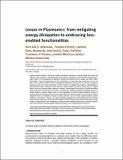Losses in plasmonics: from mitigating energy dissipation to embracing loss-enabled functionalities
Author(s)
Boriskina, Svetlana V; Cooper, Thomas A; Zeng, Lingping; Ni, George Wei; Tong, Jonathan K.; Tsurimaki, Yoichiro; Huang, Yi; Meroueh, Laureen; Mahan, Gerald Dennis; Chen, Gang; ... Show more Show less
DownloadLosses in plasmonics.pdf (2.590Mb)
OPEN_ACCESS_POLICY
Open Access Policy
Creative Commons Attribution-Noncommercial-Share Alike
Terms of use
Metadata
Show full item recordAbstract
Unlike conventional optics, plasmonics enables unrivaled concentration of optical energy well beyond the diffraction limit of light. However, a significant part of this energy is dissipated as heat. Plasmonic losses present a major hurdle in the development of plasmonic devices and circuits that can compete with other mature technologies. Until recently, they have largely kept the use of plasmonics to a few niche areas where loss is not a key factor, such as surface-enhanced Raman scattering and biochemical sensing. Here, we discuss the origin of plasmonic losses and various approaches to either minimize or mitigate them based on understanding of fundamental processes underlying surface plasmon modes excitation and decay. Along with the ongoing effort to find and synthesize better plasmonic materials, optical designs that modify the optical powerflow through plasmonic nanostructures can help in reducing both radiative damping and dissipative losses of surface plasmons. Another strategy relies on the development of hybrid photonic–plasmonic devices by coupling plasmonic nanostructures to resonant optical elements. Hybrid integration not only helps to reduce dissipative losses and radiative damping of surface plasmons, but also makes possible passive radiative cooling of nanodevices. Finally, we review emerging applications of thermoplasmonics that leverage Ohmic losses to achieve new enhanced functionalities. The most successful commercialized example of a loss-enabled novel application of plasmonics is heat-assisted magnetic recording. Other promising technological directions include thermal emission manipulation, cancer therapy, nanofabrication, nanomanipulation, plasmon-enabled material spectroscopy and thermo-catalysis, solar water treatment, and thermophotovoltaics.
Date issued
2017-10Department
Massachusetts Institute of Technology. Department of Mechanical EngineeringJournal
Advances in Optics and Photonics
Publisher
Optical Society of America
Citation
Boriskina, Svetlana V. et al. “Losses in Plasmonics: From Mitigating Energy Dissipation to Embracing Loss-Enabled Functionalities.” Advances in Optics and Photonics 9, 4 (October 2017): 775-827 © 2017 Optical Society of America
Version: Author's final manuscript
ISSN
1943-8206
